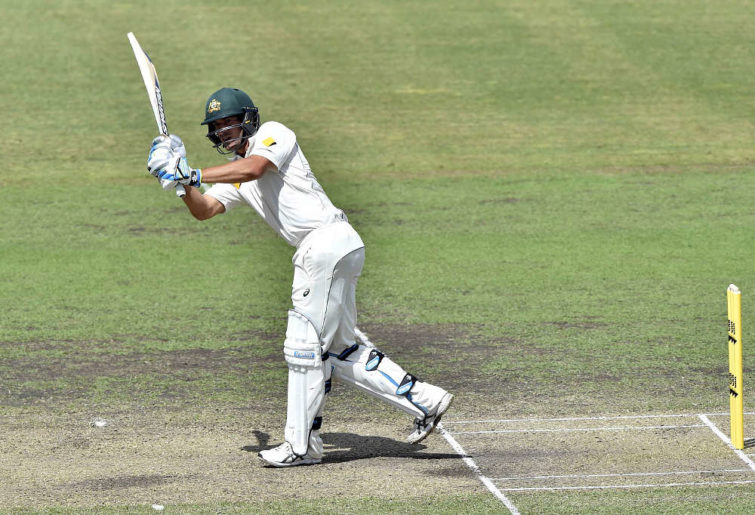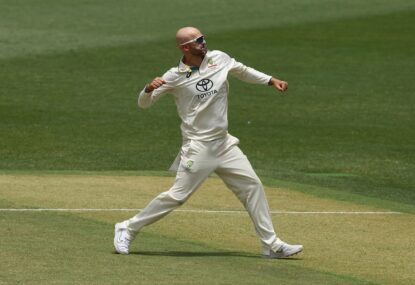Australia’s second Test against Sri Lanka threw up an intriguing opening day in the nation’s capital.
Looking at the positives for the hosts, the summer’s first Test hundreds by Australian men rescued a perilous position against a weakened opponent. In the process, Joe Burns made a case for a ticket to England, while Travis Head’s stature is growing with each Test at present.
However, it is salient to note that despite a weak opponent being depleted even further through injury, a rescue was still required due to some batting that simply cannot be replicated in the Old Dart.
Otherwise, the Australians will be eaten alive by skilled swing merchants on accommodating home tracks.
Marcus Harris played a poor shot and left early. His dismissal continued a worrying pattern of getting himself out through errors of judgement and impatience.
Increasingly it appears bowlers must do little other than wait for such an error, safe in the knowledge it will come sooner or later.
Whether Harris can adjust the mind to match the ability is unknown. At this stage his tendency to give his wicket away in favourable conditions does not promote confidence that he is the man for more searching examinations in the motherland.
The season of Usman Khawaja is a painful study in rapid decline. From arguably his career zenith in the UAE where he gave a lesson in the lost art of saving a Test match, his form has progressively plummeted over the last two months. The leaden-footed and hard-handed dismissal at Manuka on Friday will alarm selectors even more than yet another low score against his name.
It is becoming difficult to see where Khawaja fits in to a line-up that includes Steve Smith and David Warner among the top six, for others are staking their claim to the remaining four places with every match, and Khawaja averages only 19 from his previous six Test innings in England.
Other candidates for the Test top order face off presently at the Gabba, a tried and discarded young Queenslander curiously throwing down slow medium pace as an opening bowler in Teale strides, and a disgraced West Australian looking to be considered for a Test recall on the basis of whether can strike at 120.00 or better against three or more slower balls per over.
These are strange times.
The early carnage in Canberra continued with Marnus Labnuschagne’s dismissal after a very brief stay, but he can be forgiven for falling to a nice piece of bowling, and in a manner that at least did not continue any disturbing pattern. In saying that, Jimmy Anderson may have noted from the distant vantage of his own side’s Caribbean horror show, that Labnuschagne fell nibbling at a well-pitched outswinger.
The unlikeliest of events followed.
A partnership of over 300, scored at a decent rattle and peppered with attractive strokeplay was a heart-warming union for success-starved home fans. Two batsmen reaching 150 apiece in good time, looking controlled and judicious in shot selection.
We start with Burns, who now has four Test hundreds in his 16th test. He seems a player who has never captured the imagination of neither the selectors, nor the public. There is a sense that whenever Burns is in the team, many are looking for someone else to take his role, regardless of how Burns is travelling.
Perhaps it is the straight-forward style at the crease, perhaps the simple moniker that would have been at home in the Australian teams of a century prior, or perhaps now his age and previous inability to cement a spot are a factor for some, who’d prefer to see the likes of a Will Pucovski get an opportunity.
Yet you cannot argue with his effectiveness.

Joe Burns. (AFP PHOTO / Saeed KHAN)
At Manuka, he made sensible decisions in the early exchanges while his peers perished. He was aggressive in his favoured zones, with his pull shots ranging between vicious and savage.
While no bowler was swinging the ball in a perpendicular fashion, there was enough movement to challenge techniques.
All four of Burns’s tons have been in the Antipodes. However, who of his competitors for a place in the Ashes line-up can claim to know their game as well as he, at 29, and can boast a hundred every four Tests?
Selectors appear to have made a sound judgement in first elevating Travis Head to the Test XI, and then anointing him as the vice-captain. Head’s innings was one of character, discipline, and determination. These are hallmarks of his early Test career.
Upon reaching his hundred, Head showed a side to his game that we haven’t previously seen in the Test arena, the release of pressure allowing an acceleration in scoring that was equal parts entertaining and very effective in solidifying Australia’s match position.
Seeing this extra gear in Head’s transmission showed he may be a man for myriad situations, with plenty of flair to compliment the fighter within. He showed an understanding that an innings in white flannels must be built, and the right to flay must typically be first earned through graft.
He looks a keeper, and not in the Tim Paine sense. While a stern examination awaits from Anderson and company, you get the sense that Head has the game and the temperament to rise to it.
The downside of the mammoth partnership was that it highlighted the failings of those who came before. To their credit, Burns and Head survived early challenges and yes, both were dropped.
However they quickly made conditions and their opponents look like easy pickings, in the process shining an uncomfortable spotlight on their departed teammates. Some may argue it is difficult to benchmark hundreds against a struggling side which is at the end of a long tour and depleted by injury, while suffering political ructions.
The two centurions have simply put their best foot forward against the only opposition they have at present, and succeeded whether others failed. Any Test match hundred takes a solid temperament and an understanding of how to survive tough periods, until the going becomes easier.
In just his second Test match, Kurtis Patterson may argue that the other downside was his wait of circa six hours to appear at the crease. Blessed with the incredible good fortune of being the beneficiary of one the easiest dropped chances seen in recent memory from his very first ball, Patterson played some attractive strokes in the last session.
Saturday will tell whether he capitalises and makes his case to fill one of the many still-vacant seats on the plane to England. We know Head will be there, and now it seems Burns has done everything in his control to join him.






































































































